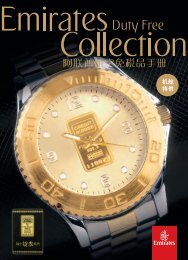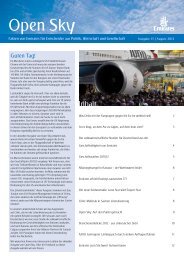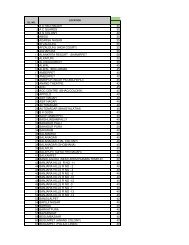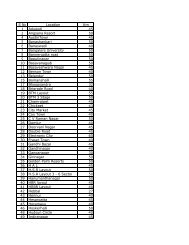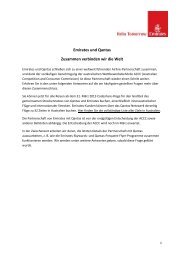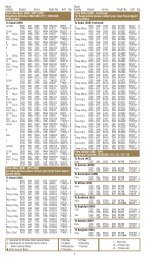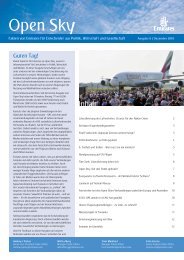Annual Report 2008-2009 - Emirates.com
Annual Report 2008-2009 - Emirates.com
Annual Report 2008-2009 - Emirates.com
Create successful ePaper yourself
Turn your PDF publications into a flip-book with our unique Google optimized e-Paper software.
2. Summary of significant accounting policies (continued)<br />
Cash and cash equivalents<br />
Cash and cash equivalents <strong>com</strong>prise all cash and liquid funds with an original maturity of three months or less and bank overdrafts.<br />
Other bank deposits with maturity less than a year are classified as short term bank deposits. Bank overdrafts, if any, are shown within<br />
current liabilities in the consolidated balance sheet.<br />
3. Critical accounting estimates and judgements<br />
In the preparation of the consolidated financial statements, a number of estimates and associated assumptions have been made relating<br />
to the application of accounting policies and reported amounts of assets and liabilities and in<strong>com</strong>e and expense. The estimates and<br />
associated assumptions are assessed on an ongoing basis and are based on historical experience and other factors, including<br />
expectations of future events that are believed to be reasonable under the circumstances. The following discussion addresses the<br />
accounting policies that require subjective and <strong>com</strong>plex judgements, often as a result of the need to make estimates.<br />
Valuation of intangible assets on acquisition<br />
For each acquisition management assesses the fair value of intangible assets acquired. The instance where individual fair values of<br />
assets in a group are not reliably measurable, a single asset separate from goodwill is recognised. Where an active market does not<br />
exist for an intangible asset, fair values are established using valuation techniques e.g. discounting future cash flows from the asset. In<br />
the process, estimates are made of the future cash flows, the useful life and the discount rate based on management’s experience and<br />
expectation at the time of acquisition.<br />
Depreciation of property, plant and equipment<br />
Management assigns useful lives and residual values to property, plant and equipment based on the intended use of assets and the<br />
economic lives of those assets. Subsequent changes in circumstances such as technological advances or prospective utilisation of the<br />
assets concerned could result in the actual useful lives or residual values differing from initial estimates. Management has reviewed the<br />
residual value and useful lives of major items of property, plant and equipment and determined that no adjustment is necessary.<br />
Amortisation of intangible assets<br />
Management assigns useful lives and residual values to intangible assets based on the intended use of the assets, the underlying<br />
contractual or legal rights and the historical experience. Subsequent changes in circumstances such as technological advances,<br />
changes in the terms of the underlying contracts or prospective utilisation of the assets concerned could result in the useful lives or<br />
residual values differing from initial estimates. Management has reviewed the residual values and useful lives of major intangible assets<br />
and determined that no adjustment is necessary.<br />
Impairment of investment in associated <strong>com</strong>panies and joint ventures (equity accounted investments)<br />
Management applies the guidance in IAS 39 to identify if potential impairment exists for its equity accounted investments. At each<br />
balance sheet date, an assessment is made whether there is any objective evidence of impairment. In such instances, the investment is<br />
subject to an impairment test by <strong>com</strong>paring the carrying amount to the recoverable amount of the asset. Considering the long term<br />
nature of these investments, the recoverable amount is determined based on value-in-use calculations. Calculating the value-in-use<br />
implies obtaining cash flow forecasts from the management of the equity accounted investments. Publicly listed <strong>com</strong>panies often<br />
operate under restrictions due to the applicable listing regulations on disclosure of information to a selective group of shareholders.<br />
Thus, for such investments management develops its own estimated cash flows using publicly available data or the analyst forecasts, as<br />
appropriate.<br />
121





